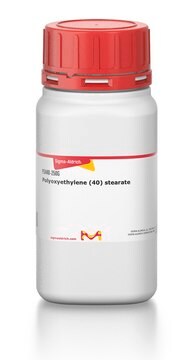86694
Tetraethylene glycol monododecyl ether
BioXtra, ≥98.0% (GC)
Synonym(s):
C12E4, Dodecyl tetraethylene glycol ether, Dodecyltetraglycol
About This Item
Recommended Products
description
non-ionic
product line
BioXtra
Assay
≥98.0% (GC)
form
liquid
mol wt
362.54 g/mol
refractive index
n20/D 1.450-1.454
density
0.946 g/mL at 20 °C (lit.)
cation traces
Ca: ≤50 mg/kg
Cd: ≤50 mg/kg
Co: ≤50 mg/kg
Cr: ≤50 mg/kg
Cu: ≤50 mg/kg
Fe: ≤50 mg/kg
K: ≤50 mg/kg
Mg: ≤50 mg/kg
Mn: ≤50 mg/kg
Na: ≤50 mg/kg
Ni: ≤50 mg/kg
Pb: ≤50 mg/kg
Zn: ≤50 mg/kg
SMILES string
CCCCCCCCCCCCOCCOCCOCCOCCO
InChI
1S/C20H42O5/c1-2-3-4-5-6-7-8-9-10-11-13-22-15-17-24-19-20-25-18-16-23-14-12-21/h21H,2-20H2,1H3
InChI key
WPMWEFXCIYCJSA-UHFFFAOYSA-N
Looking for similar products? Visit Product Comparison Guide
General description
Application
- as a water-soluble surfactant in computational and physical experiments to report the post-deposition motion of the surfactant front and the deformation of the subphase surface using Marangoni flow and capillary waves
- to study its mixed micellization and interfacial properties in the absence and presence of sodium propionate
- to investigate the phase transformation of C12E4 aqueous solutions by Rayleigh light scattering (RLS) when adopting different heating ways
Signal Word
Warning
Hazard Statements
Precautionary Statements
Hazard Classifications
Aquatic Acute 1 - Aquatic Chronic 1 - Eye Irrit. 2 - Skin Irrit. 2 - STOT SE 3
Target Organs
Respiratory system
Storage Class Code
10 - Combustible liquids
WGK
WGK 2
Flash Point(F)
235.4 °F - closed cup
Flash Point(C)
113 °C - closed cup
Personal Protective Equipment
Regulatory Listings
Regulatory Listings are mainly provided for chemical products. Only limited information can be provided here for non-chemical products. No entry means none of the components are listed. It is the user’s obligation to ensure the safe and legal use of the product.
PRTR
Class I Designated Chemical Substances
FSL
Group 4: Flammable liquids
Type 3 petroleums
Hazardous rank III
Water insoluble liquid
ISHL Indicated Name
Substances Subject to be Indicated Names
ISHL Notified Names
Substances Subject to be Notified Names
JAN Code
86694-5ML:
86694-BULK:
86694-1ML:
86694-VAR:
Certificates of Analysis (COA)
Search for Certificates of Analysis (COA) by entering the products Lot/Batch Number. Lot and Batch Numbers can be found on a product’s label following the words ‘Lot’ or ‘Batch’.
Already Own This Product?
Find documentation for the products that you have recently purchased in the Document Library.
Customers Also Viewed
Our team of scientists has experience in all areas of research including Life Science, Material Science, Chemical Synthesis, Chromatography, Analytical and many others.
Contact Technical Service








